Key takeaways
- Drone photography transforms perspectives, allowing unique and expansive views of nature while minimizing disturbance to wildlife.
- Choosing the right equipment, with a focus on stability, camera quality, and portability, enhances the overall creative process.
- Understanding legal regulations and ethical considerations is essential to responsibly capturing nature without infringing on privacy or harming wildlife.
- Preparation, such as scouting locations and experimenting with altitude, is key to capturing stunning and emotionally resonant nature shots.
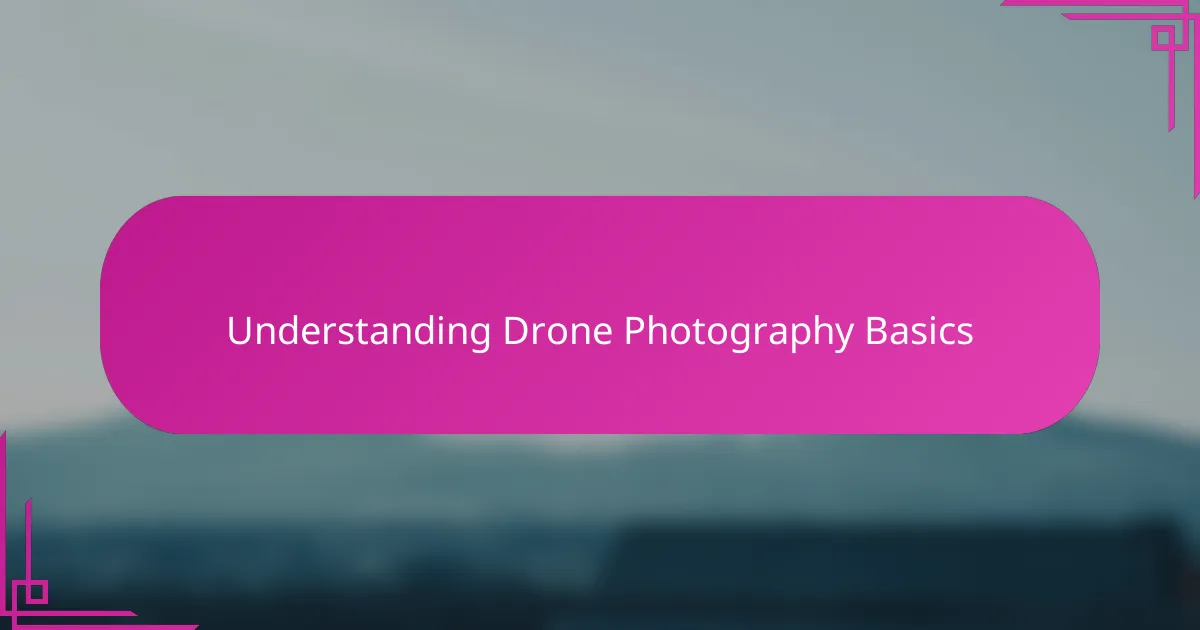
Understanding Drone Photography Basics
When I first started with drone photography, grasping the basics felt like unlocking a new language of visual storytelling. Understanding how drones hover steadily or capture sweeping panoramas changed the way I saw nature—not just as static scenes but as dynamic worlds waiting to be explored from above. Have you ever wondered how controlling altitude and angle impacts the mood of a shot? It’s fascinating how small adjustments create entirely different emotions in the final image.
Learning the technical side—like mastering flight controls and camera settings—was initially intimidating but quickly became second nature. I found that patience and practice were key; each flight taught me a bit more about balancing stability and creativity. This foundation made me appreciate the blend of skill and artistry that drone photography demands.
What really struck me was the responsibility that comes with flying a drone outdoors. Respecting wildlife and environments means flying thoughtfully and legally, which adds another layer of meaning to the craft. This awareness helped me connect more deeply with both the technology and the natural world I was capturing.
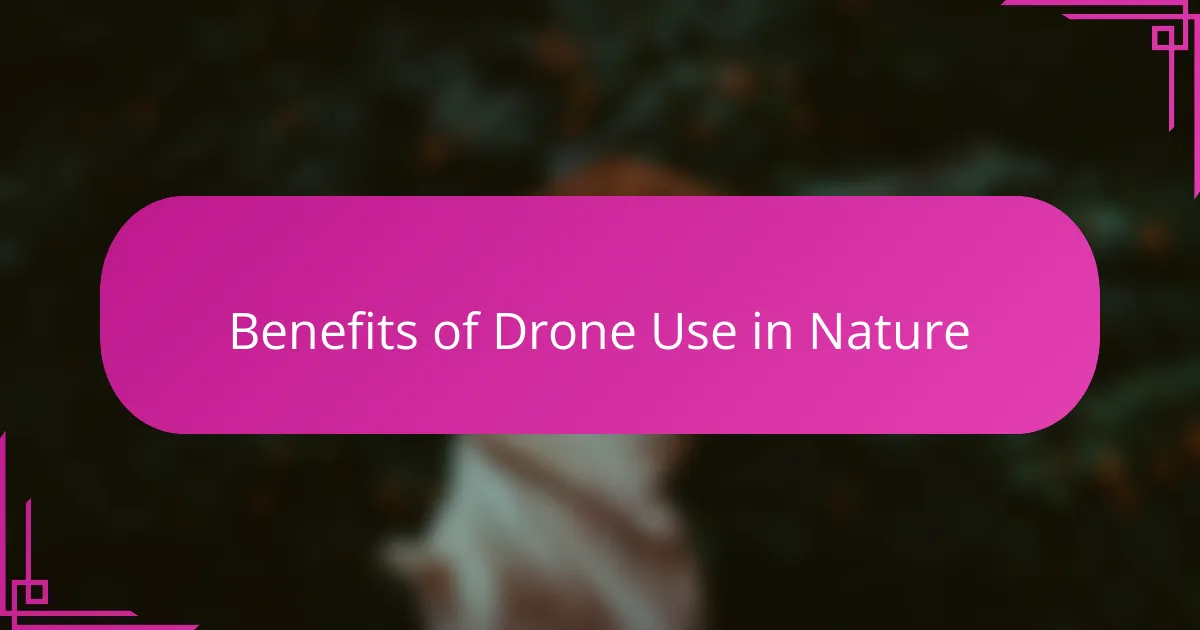
Benefits of Drone Use in Nature
One of the biggest benefits I noticed using drones in nature is the ability to reach perspectives that are otherwise impossible or dangerous to access. Flying above dense forests or over rugged cliffs lets me capture expansive scenes that feel like a revelation, revealing patterns and textures I never imagined existed. Have you ever stood on a hilltop and wished you could see what lies beyond the next ridge? A drone provides that eye in the sky.
Another advantage is how drones allow for minimal disturbance to wildlife and their habitats. When I’m photographing from a distance high in the air, animals carry on without any stress or change in behavior. This made me realize how respectful technology can be when used thoughtfully—no bushes trampled, no nests disturbed, just authentic moments preserved from afar.
Lastly, the creative freedom drones offer constantly surprises me. With the smooth movement and flexible angles, I can experiment with storytelling in ways traditional photography can’t. Sometimes, it’s the tiniest tilt or a slow glide that brings a scene to life, capturing not just an image but an emotion that resonates deeply. Don’t you think that’s the magic of seeing nature from a fresh vantage point?
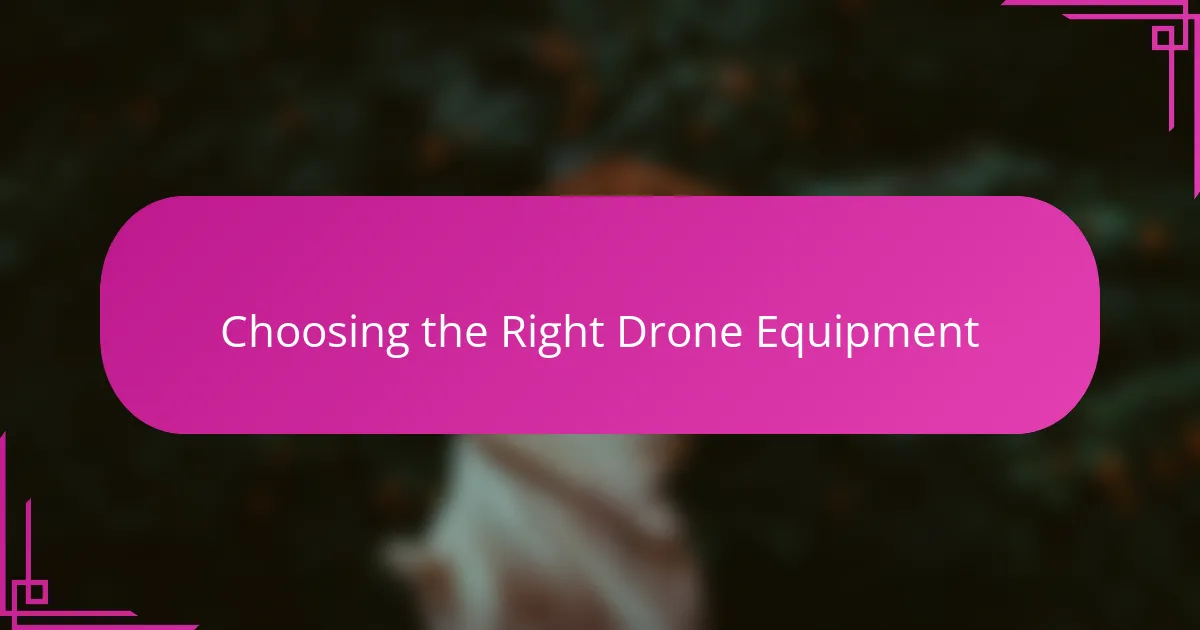
Choosing the Right Drone Equipment
Choosing the right drone equipment felt like a crucial step in making my vision come alive. I quickly realized that not all drones are created equal—some models offered incredible camera quality but sacrificed battery life, while others were sturdy but less nimble. Have you ever struggled with a drone that just couldn’t keep steady in the wind? That experience taught me to prioritize stability and weather resistance for outdoor shoots.
Camera specs were another game-changer for me. I used to think megapixels were everything, but learning about sensor size and lens options opened my eyes to what truly affects image quality. A drone with manual camera controls allowed me to tweak exposure and shutter speed, which made a huge difference in capturing the subtle light shifts during sunrise over the forest.
Battery life and portability also influenced my choices more than I expected. Carrying heavy gear through rough terrain quickly became exhausting, so I gravitated toward lighter drones that didn’t compromise on performance. Don’t you find that when your equipment feels like an extension of you, the creative process flows so much easier? That’s what happened when I found the right balance between power and convenience.
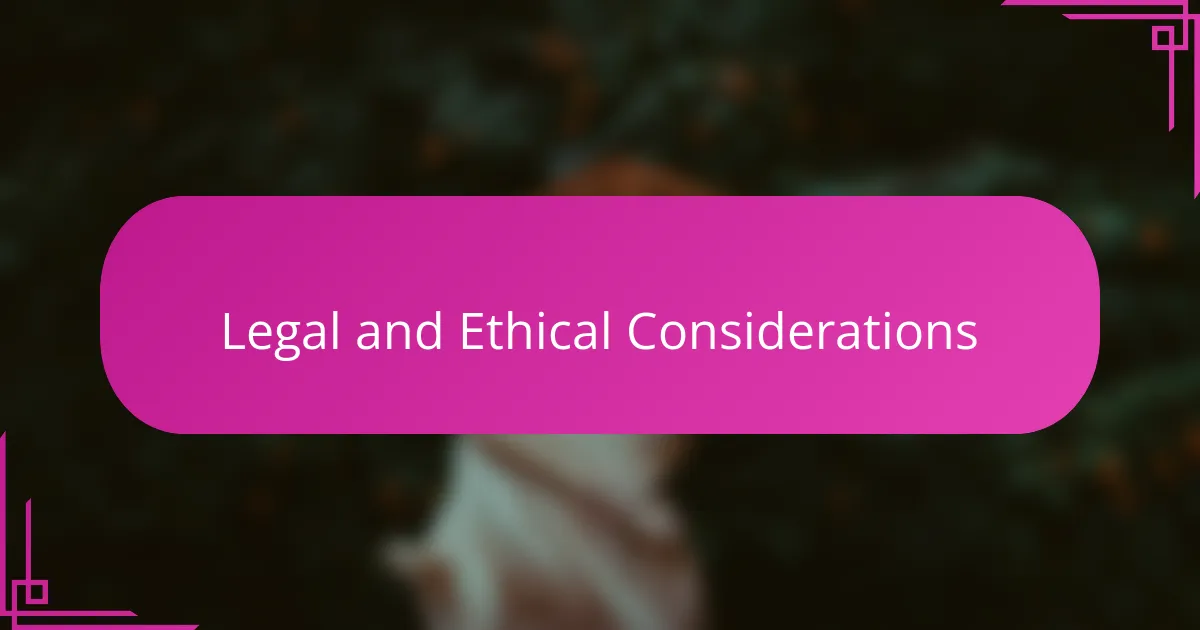
Legal and Ethical Considerations
Flying a drone over nature brings a thrilling sense of freedom, but it also made me realize how important it is to fly within legal boundaries. I learned early on that knowing local regulations—like no-fly zones and altitude limits—is not just about avoiding fines, but about protecting the spaces I care about. Have you ever felt that mix of excitement and caution before launching your drone? That balance is crucial.
Ethically, I’m constantly aware of how my presence could impact wildlife. Once, I had to abort a shot because a bird started showing distress, and it hit me how fragile those moments are. Isn’t it amazing how a simple decision to back off can mean preserving the authenticity of a scene rather than forcing a perfect shot?
Respecting privacy is another layer I can’t overlook. I always ask myself if my drone’s view might invade someone’s personal space or disrupt their peace. For me, maintaining trust and minimizing intrusion makes the art of drone photography feel not just creative, but also responsible and respectful.
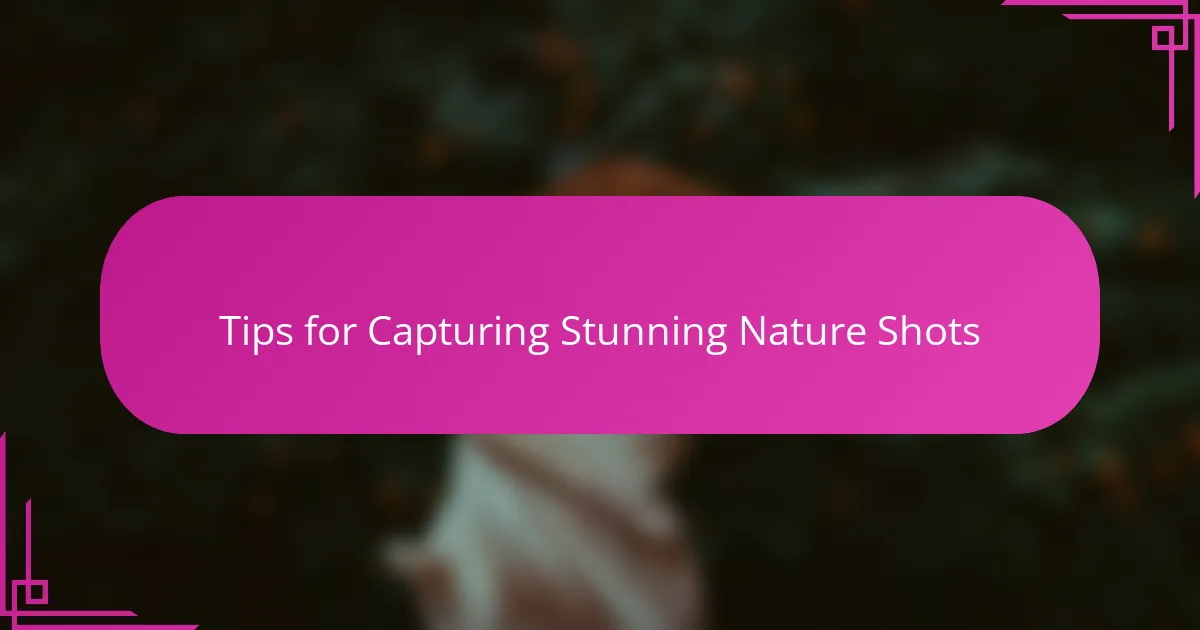
Tips for Capturing Stunning Nature Shots
One tip that reshaped my approach was learning to scout locations ahead of time. Arriving with a mental map of where the sunlight hits or where wildlife tends to gather made my shots more intentional. Have you noticed how the right light angle can turn an ordinary tree line into a glowing mosaic? Timing, to me, is everything.
Another thing I’ve found valuable is experimenting with different altitudes to find that sweet spot between detail and grandeur. Sometimes flying low reveals textures in the foliage I never expected; other times, soaring high paints the landscape in epic scale. Don’t you find that flexibility gives you a storytelling toolkit unlike any other?
Finally, I always remind myself to keep the drone steady and movements smooth. Jarring or fast maneuvers can distract and ruin the immersive feel I’m after. Practicing gentle glides and slow pans has helped me capture scenes that feel almost cinematic—inviting viewers right into the heart of nature’s beauty. Have you tried layering these subtle motions to add emotion to a shot? It’s a game-changer in my experience.
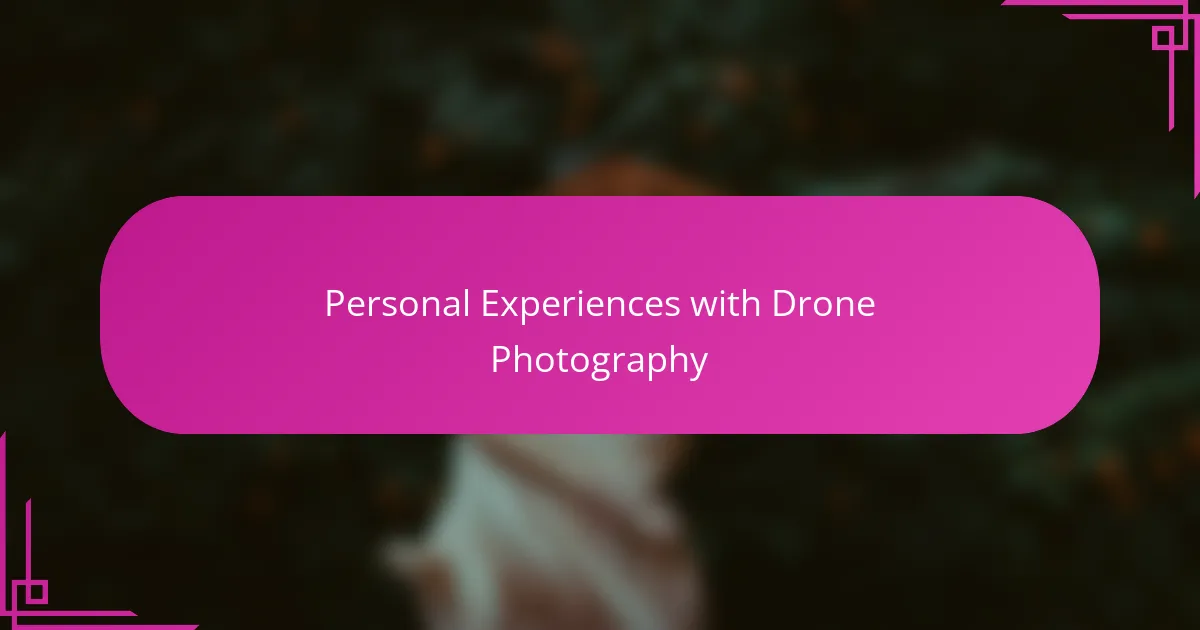
Personal Experiences with Drone Photography
Flying my drone for the first time over a serene lake at dawn was unforgettable. I remember holding my breath as the camera captured the mist curling above the water, a perspective I couldn’t have achieved on foot. Have you ever felt that perfect blend of excitement and calm, knowing you’re witnessing a secret side of nature?
There was also a moment when I nearly lost control during a swift gust of wind above a canyon rim. That heart-stopping experience taught me how vital patience and quick reflexes are, and it deepened my respect for the risks involved in this art. It made me realize drone photography isn’t just about creativity—it’s about connection and trust between pilot and machine.
One of my favorite discoveries has been how drones can reveal hidden patterns in nature—like the spirals of a flower field or the braided flow of a river—from an aerial vantage point. Capturing those surprising details fuels my passion every time. Don’t you find that seeing nature this way turns photography into a kind of joyful exploration?